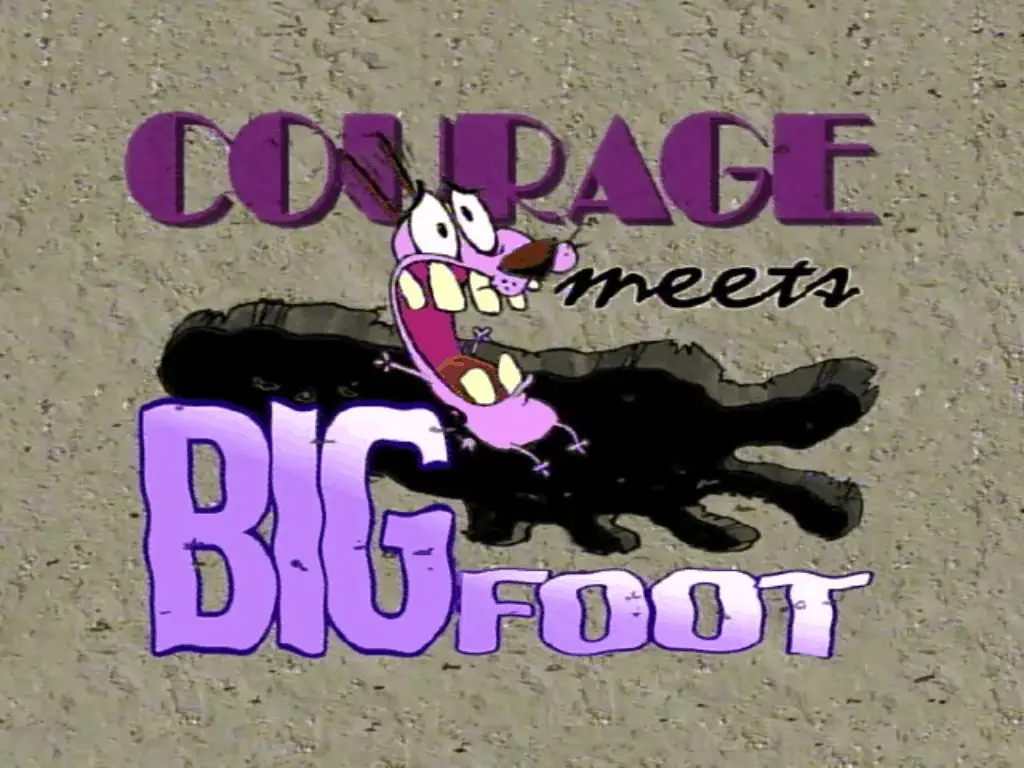In the “Big Foot” episode of Courage The Cowardly Dog we have a story which makes use of the legend of Big Foot.
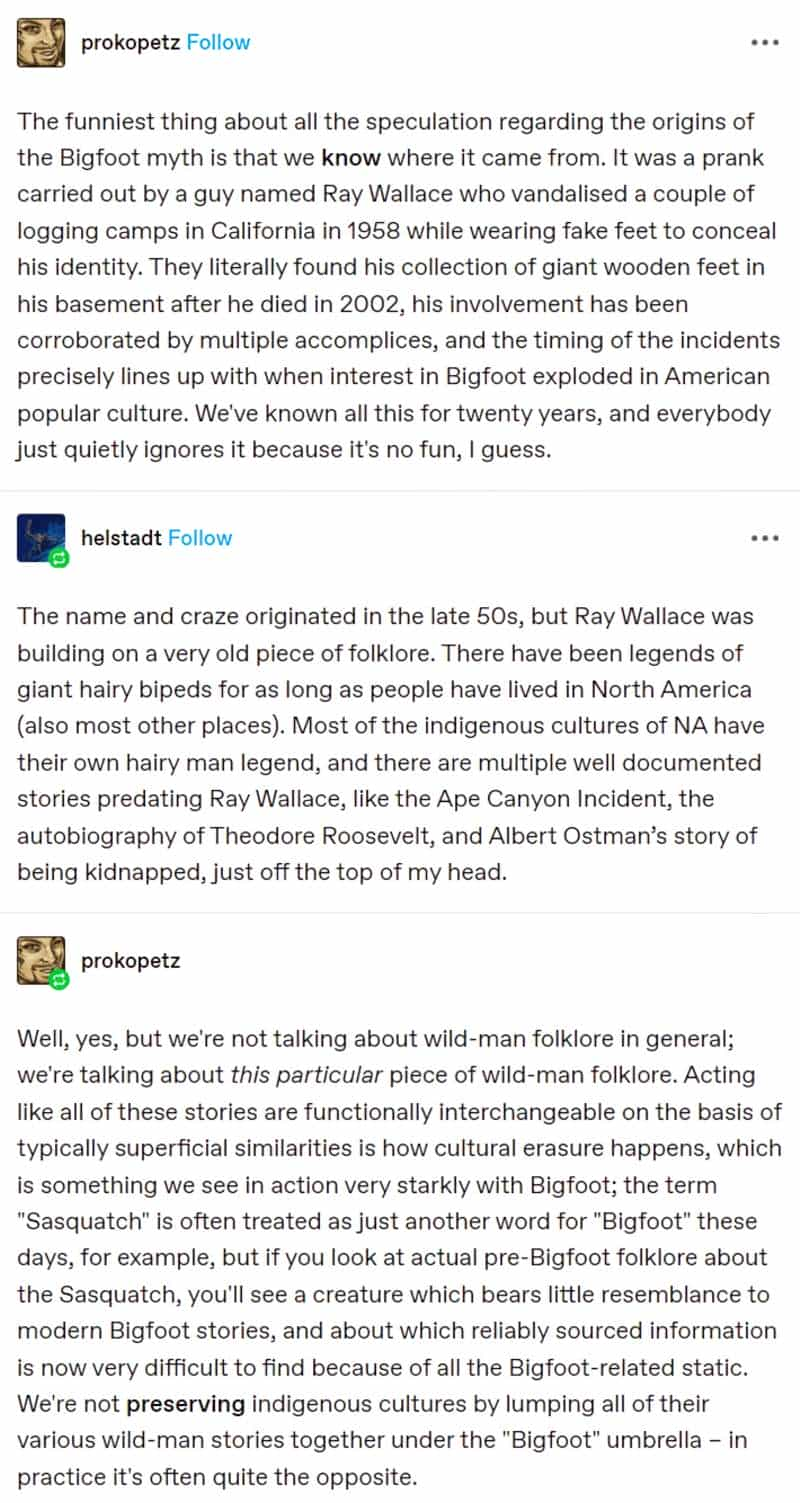
The great thing about the horror comedy genre is that writers not only have access to a treasure trove of metaphors and symbols — they also have access to urban legends and conspiracy theories.
Bigfoot (also known as Sasquatch) is a mythological simian, ape, or hominid-like creature that is said to inhabit forests, mainly in the Pacific Northwest. In American folklore, Bigfoot is usually described as a large, hairy, bipedal humanoid. The term sasquatch is an Anglicized derivative of the Halkomelem word sásq’ets.
Wikipedia
(Here in Australia we have ‘Yowie’.)
This legend is combined with the classic movie Godzilla when Courage transmogrifies into a monster, stepping on cars and buildings. Presumably Courage has seen this film in the world of the story. It doesn’t matter if the child audience hasn’t. It still works.
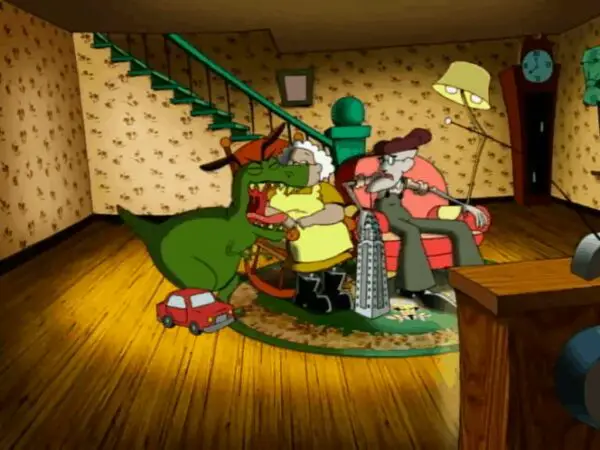
Windmill Symbolism
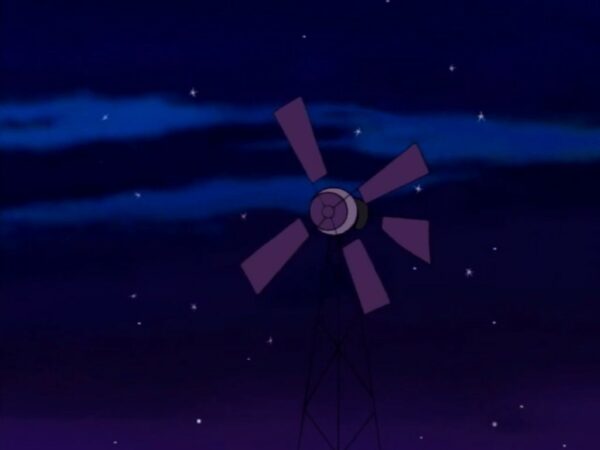
At the risk of reading too much into the opening image, it’s worth asking why the animators chose to open with a medium shot of the windmill before showing us the entire scene.
The most famous windmill in literature is the one in Animal Farm, but I doubt this one has anything to do with that. If anything, I’d say that ‘change is on the wind’.
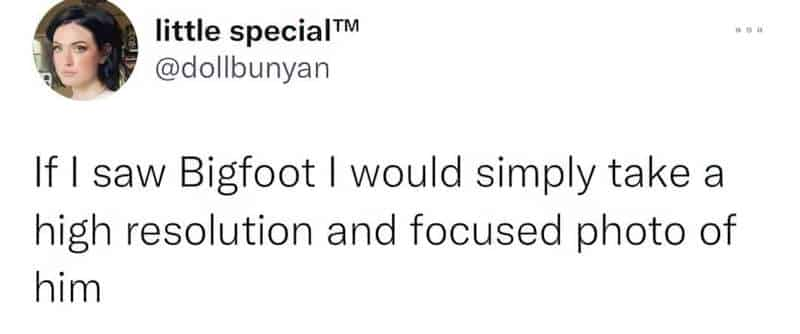
STORY STRUCTURE OF “BIG FOOT”
Like the other Courage stories, Courage discovers a threat, fights against the threat and wins out in the end. The Bagge household will end happily ever after… until next time.
SHORTCOMING
As in all of the stories in this series, Courage is the ‘everyman’ hero. Blake Snyder calls this kind of a hero ‘dude with a problem’. An ordinary guy finds himself in extraordinary circumstances. He is thrust into a circumstance he is ill-equipped to deal with. Other examples of the everyman hero are Bilbo Baggins (Lord of the Rings), Arthur Dent (Hitchhiker’s Guide To The Galaxy) and Edmund Pevensie (Chronicles of Narnia).
Hence, Courage is innocently fixing himself an archetypically American after dinner snack of milk and pie when he is scared by something outside.
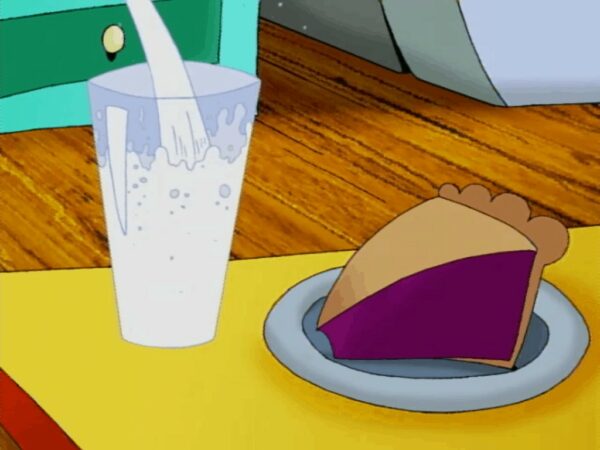
He is not taken seriously by his owners. This is underscored in every episode, not least because it provides another opportunity for comedy.
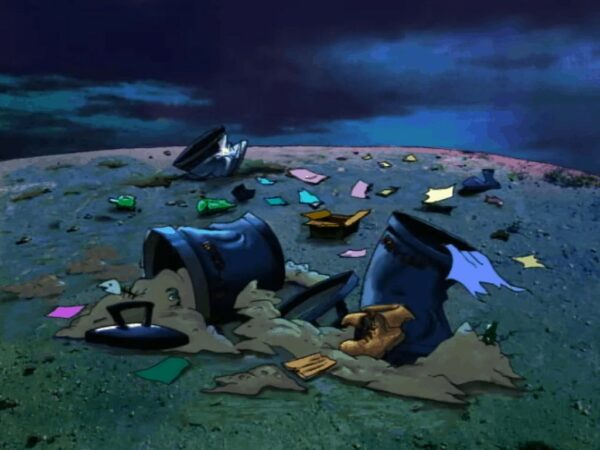
The Significance Of Windows
The window is the ‘portal‘ between the inside and outside of the safe, family house. We see it a lot in Courage stories set in and around the house. We see Courage looking out, we see him as an outsider ourselves. This dichotomy is tied to the fact that Courage has opponents both inside and outside the house.
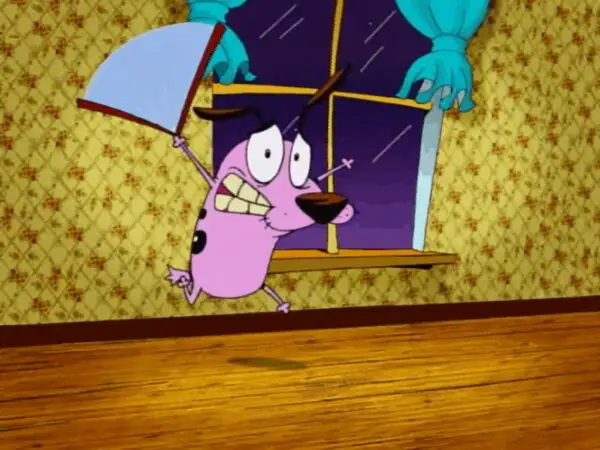

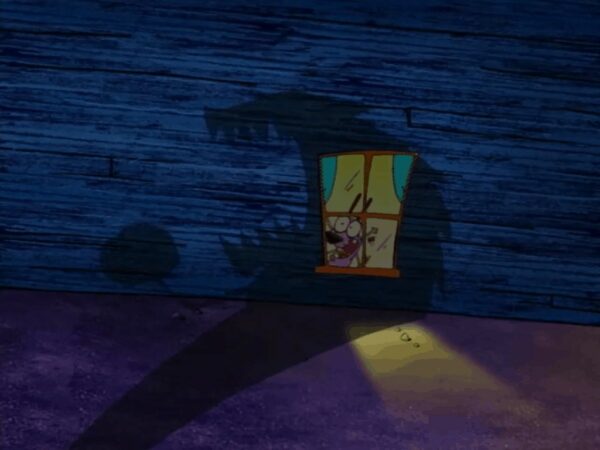

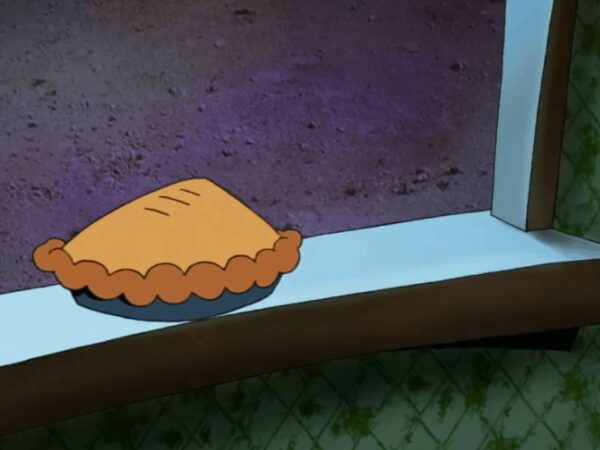
Muriel has left a pie to cool on the window sill. Courage sees it moving suspiciously — Muriel has unwittingly left it out as bait. In a calamitous action sequence involving mainly himself, he ends up covered in pie (a ‘pie in the face’ sequence) and also all over the wall. The pie in the face thing has been done so many times it’s a wonder it’s still funny. Actually, the main comedy here is that Muriel appears and says, in the midst of great mess, “Courage. Next time use a plate.” This is funny because it’s both unexpected but completely expected of Muriel.
This scene also foreshadows the food fight which will happen later.
I mention it here because finding himself covered in pie is emblematic of Courage’s shortcoming: He gets too anxious to think straight. He ends up looking silly and so even Muriel doesn’t take him seriously.
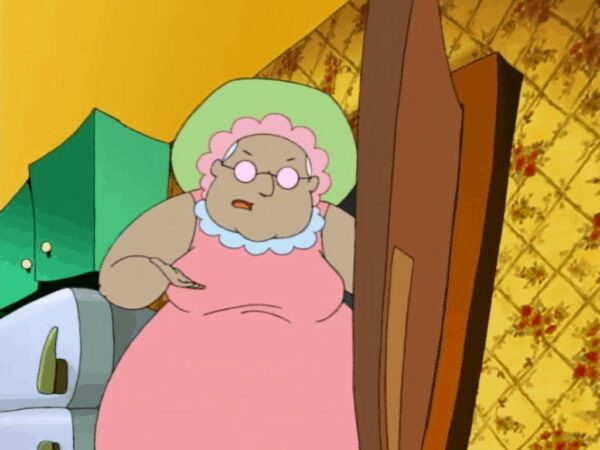
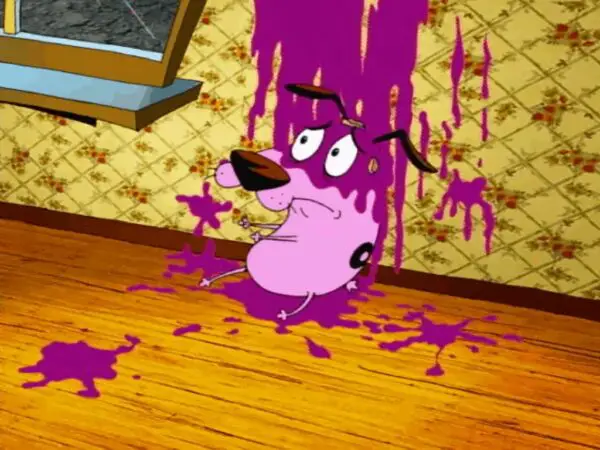
DESIRE
Courage wants to protect Muriel from this dark shadow.
OPPONENT
- The monster is first revealed as a dark shadow.
- Next we see reports of a Big Foot sighting on the nightly news.
- Courage finds a massive footprint in the dust and imagines the worst.
- Next, Big Foot is in the house.
The other opponent is, of course, Eustace. Having an opponent both inside and outside the house makes for a fuller, more satisfying narrative. A story doesn’t absolutely need both. In Roald Dahl’s The Twits, for instance, a husband and wife are the only opponents. That story feels slower in pace compared to this one. Because of the pace of a cartoon, more story is needed to fill a shorter amount of time.
Eustace’s plan suits him because he is a one-sidedly evil character. He is only interested in fame and fortune — the common denominator when it comes to cartoon baddies. Every now and then you also get a sadistic one (Eustace himself is often sadistic, especially when Courage is already scared and he pulls out his mask), or one with an insatiable appetite (e.g. Katz of the Katz motel, the fox who kidnapped Muriel for his Cajun stew).
PLAN
Courage pulls out a pair of gigantic binoculars. The comedy here is that in order to find a Big Foot you need big binoculars. In other words, Courage doesn’t understand commonsense science.
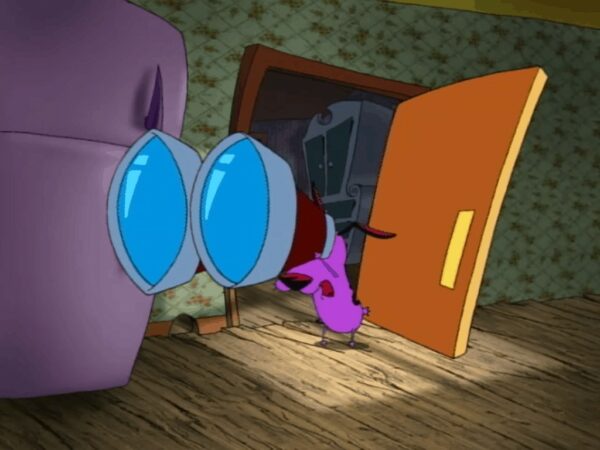
He goes in search of the footprint he and Eustace saw on the television. He uses an oversize magnifying glass.
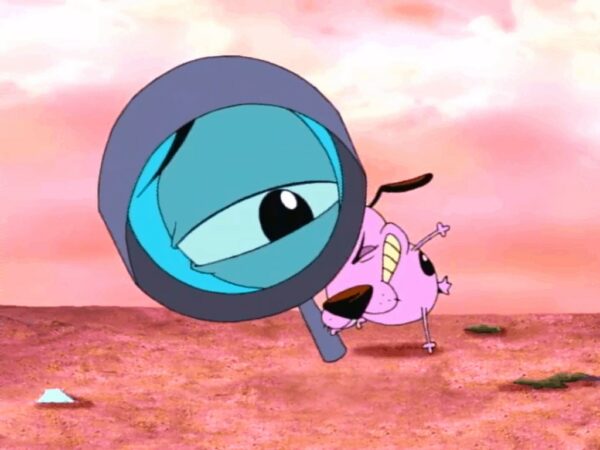
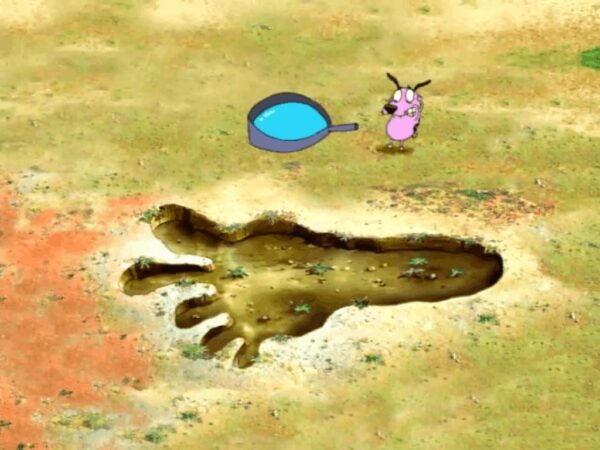
Meanwhile, Eustace has a plan of his own. He wants to catch the Big Foot for financial gain. Comedy is derived from the fact that the reward for catching such a formiddable creature is a paltry $25 plus a lifetime subscription (to I’m not sure what). A similar gag is used in an episode of Seinfeld, in which Kramer jumps the gun in his coffee scalding lawsuit and ruins his chance of winning $50k compensation due the company first offering him a lifetime supply of free coffee.
In this episode, it is Eustace who stars in the bulk of the ‘plan’ segment. We see him lay out all sorts of hunting equipment across the table. What on earth he’s going to do with a fishing rod and a tennis racket we can only guess. Comedy comes from the juxtaposition between the size of a hypothetical Big Foot and the ridiculousness of the weaponry.
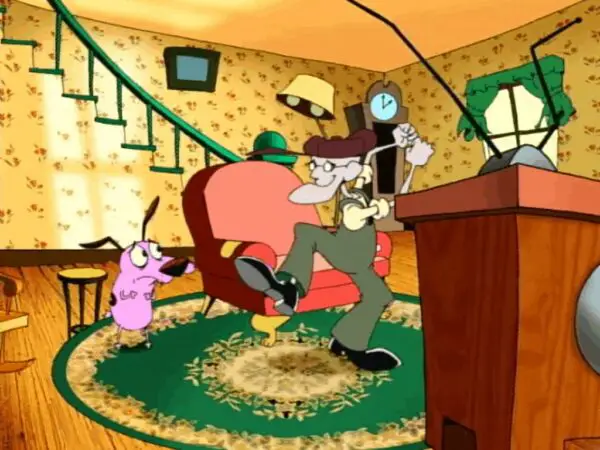
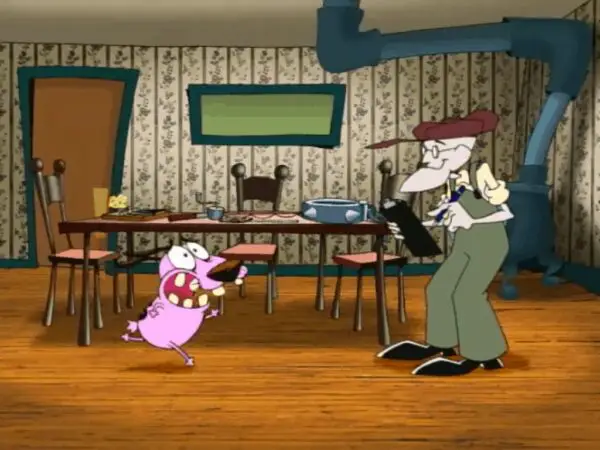
BIG STRUGGLE
Courage throws some food at the Big Foot when he sees it in the kitchen. This starts a food fight. All the while, Muriel enjoys a ‘wee cup of tea’ in her kitchen rocking chair, oblivious to all of this in Mr Magoo tradition.
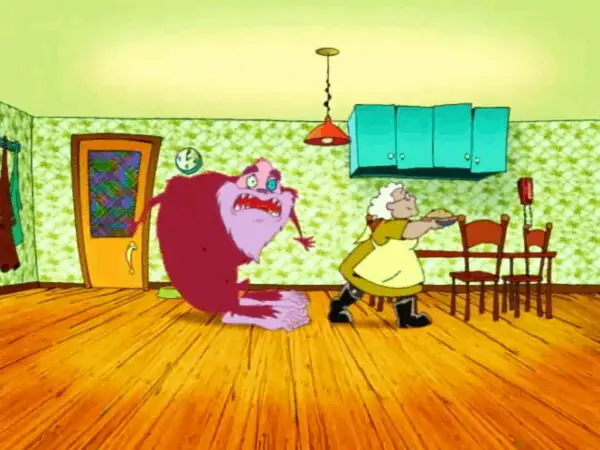
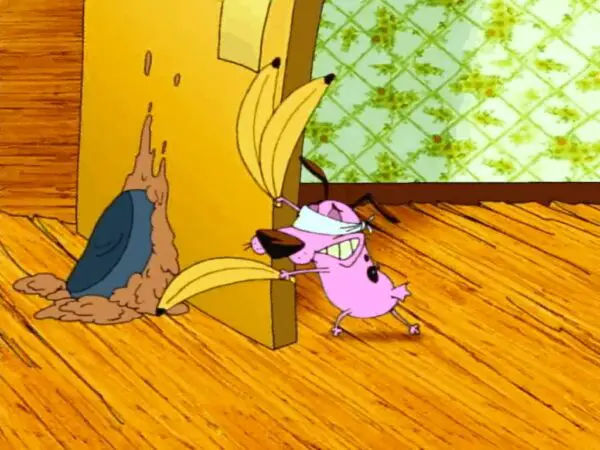
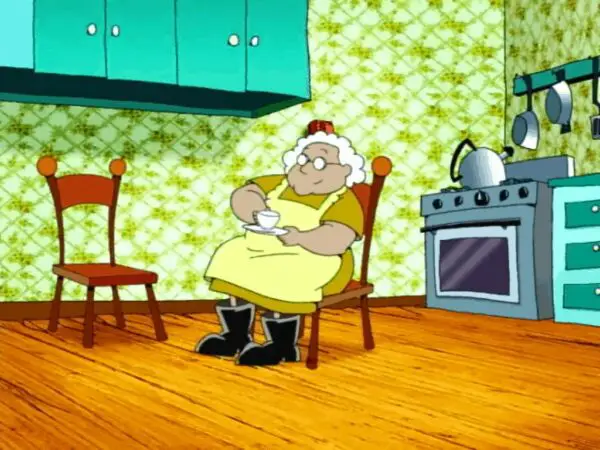
The big struggle inside the house is followed by an assault from outsiders — the faceless crowd (masterfully depicted as a single black mass) who try to knock the door down, hoping to run the monster out of town.
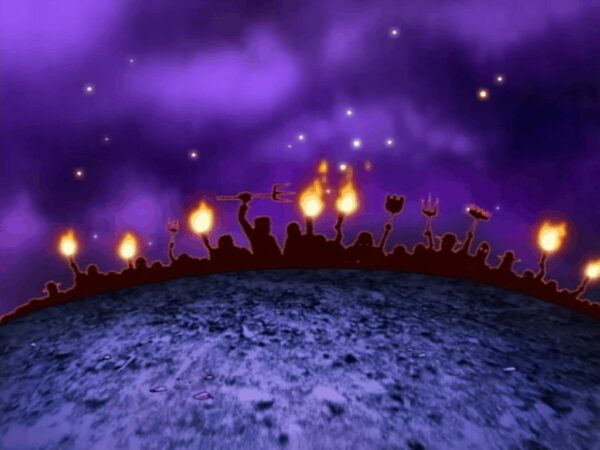
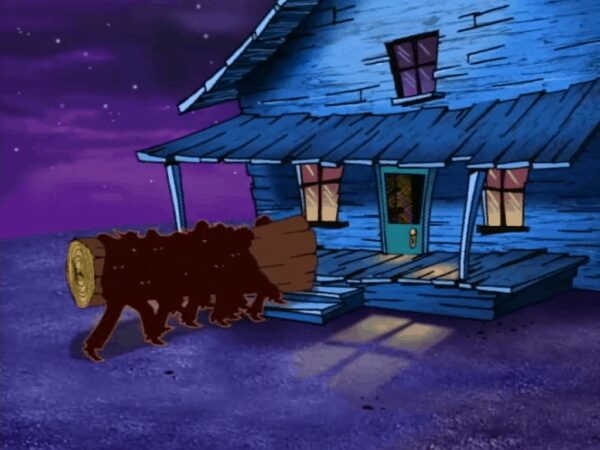
SELF-REVELATION
It’s clear by now that in this comedy series there is no ‘self’ revelation. Comedic characters never grow. They start in the exact same place they were last time at the beginning of the next episode.
The revelation happens with the Big Foot starts dancing like a Hawaiian. He is not a scary monster after all. He is cute and fluffy. This is the story structure of many picturebooks featuring monsters. Publishers like them because of our tradition of reading stories to children before bed. These stories have squeezed out the more truly horrifying stories, which are less likely to be published.
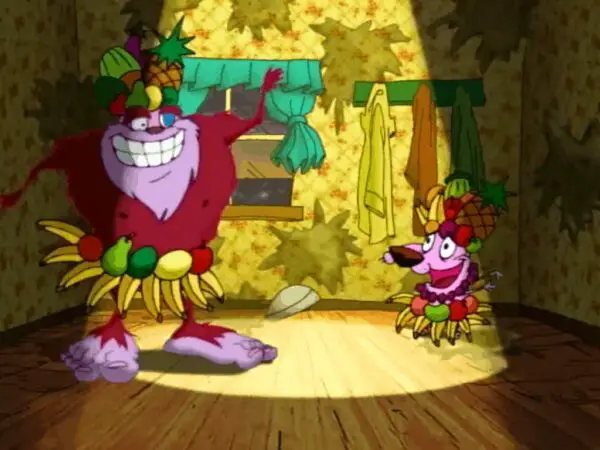
The key challenge for the storytellers here was in the switch between the end of the food fight and the beginning of the dance.
The audience has been helped along somewhat with the foreshadowing (kept from Muriel) that a little old woman has come to the door looking for her lost son. The audience knows to wonder if this woman is legitimate. In stories such as Snow White we’ve seen little old ladies who are actually witches underneath.
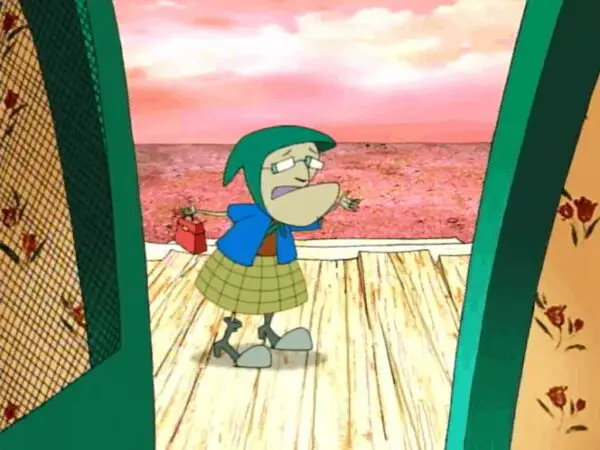
NEW SITUATION
Big Foot’s mother comes out of the crowd. Mother and son (daughter?) are reunited.

Evil Eustace tries to steal the child Big Foot back for his own selfish gains but Muriel orders him to “take the cuff off the child”. Since Eustace is a psychological child himself, he does.
The story ends with a long shot of the house, and a crescent moon behind it.
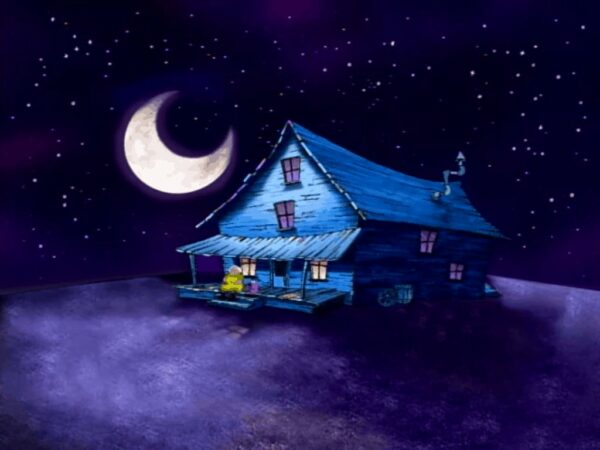
Contrast this with the establishing shot:
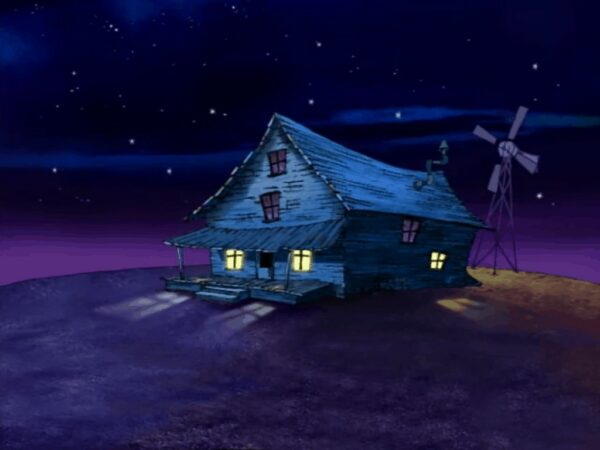
And a transition shot:

It’s clear that the moon in Courage The Cowardly Dog is a magical entity which can wax and wane over the course of a single day.
FOR FURTHER INVESTIGATION
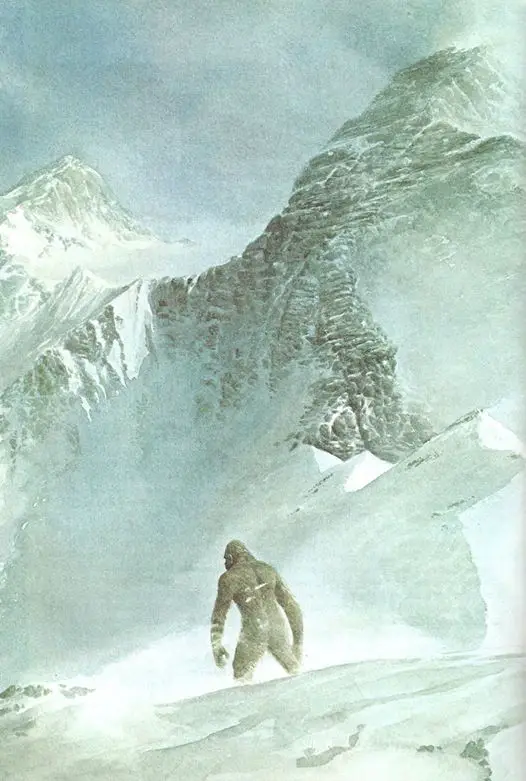
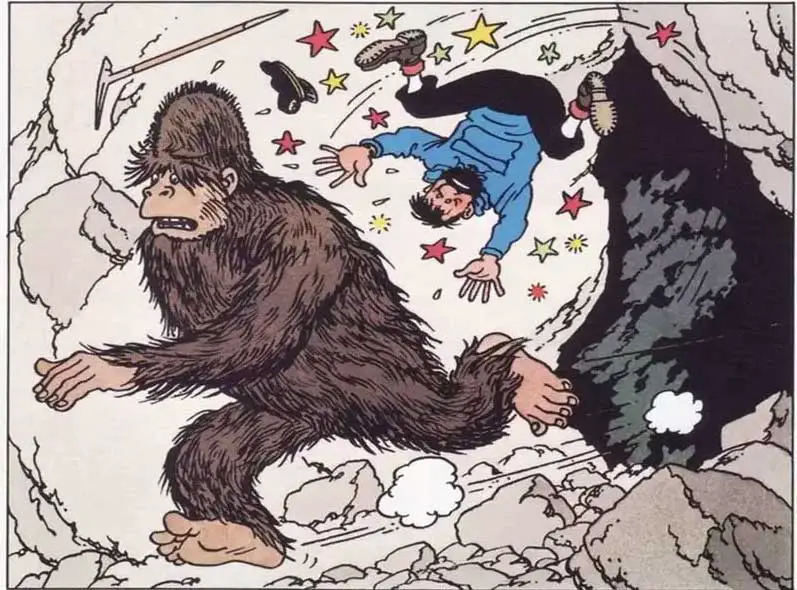
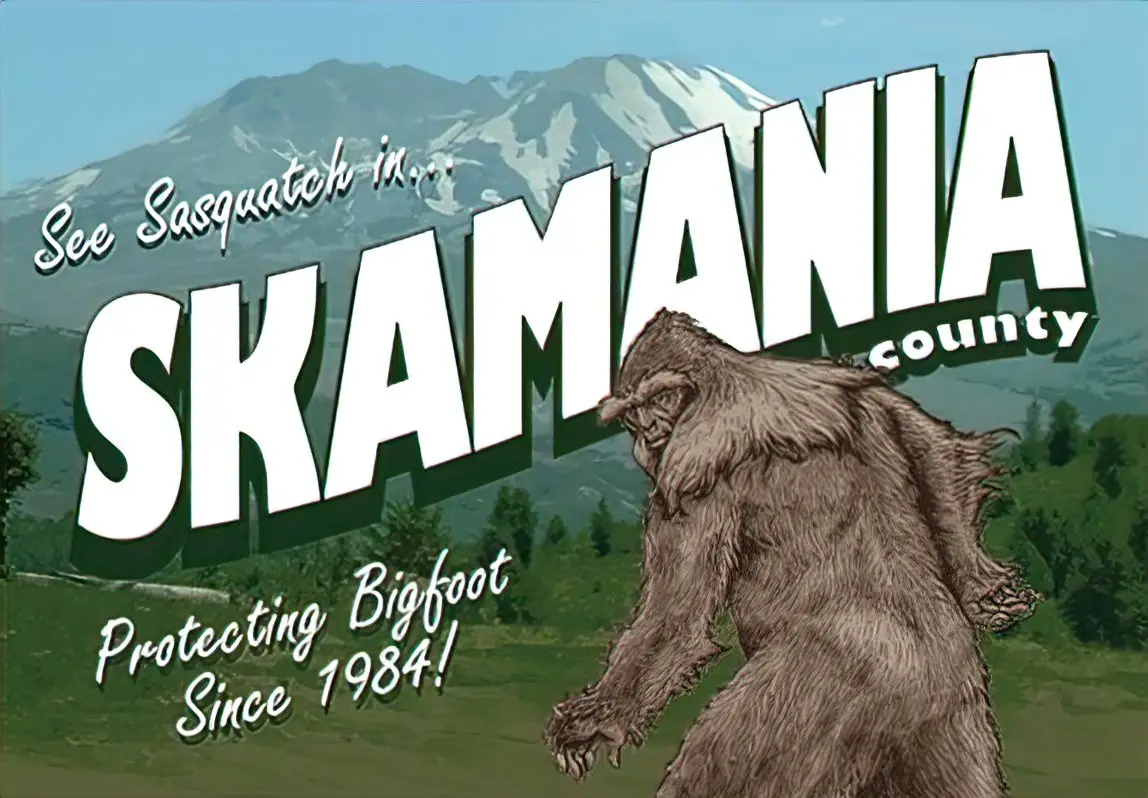
Ape expert Jane Goodall tells why she believes in Big Foot from Daily Grail
